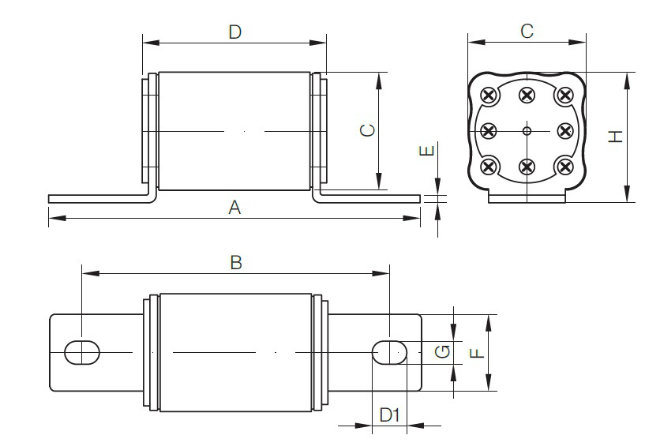RS0/RS3 Series Bolt Type Fast-Blow Fuse
Application
Support parts of this series fuse for AC 50Hz, rated insulation voltage up to 690V, thermal current to 125A, mainly used in electrical wiring in size to 22 x 58 as the various use categories (gG, aM, aR, etc.) fuse support pieces. Support parts of this series with a fuse withstand thermal current and expected impact of current sprint to 100KA dynamic thermal stability capabilities. Combined with a multi-phase fuse isolators function. One model RT18N the fuse on the support of about two pieces of a road into the outlet, both isolated power function; RT18L with a safety locking device, lock the load in the off state can melt pieces, to ensure that no misuse; also with fuse indicator, lights indicating fuse is blown.
This series of fuse support pieces in line with national standards GB13539.1, GB13539.2, GB13539.6, GB14048.3 Work standards and international power IEC60269-1, IEC60269-2, IEC269-1, IEC947-3.
Structural features
This series of fuse supports the suppression of shell pieces of plastic contact and mounted on a set piece after melting by riveting or welding, have a heterogeneous structure can be formed. FB15C, FB16-3J, FB19C-3J, RT19 forthe open type, other models are semi-enclosed structure. Which RT 18N, RT 18B and RT 18C in the same dimensions of the base, choose from five different sizes of the configuration fuses; RT 18N has two inlet and outlet, all the way to configure the appropriate size of the fuse body, the other way for a double break point, often open contact, a single support piece with isolated power function; RT18-based support pieces are TH35mm rail mount, which RT 18L also with safety locking device to ensure that support disconnected pieces of misuse does not occur.
Basic data
Model, rated insulation voltage, thermal current, the configuration cylinder cap fuse size, shape and size of the table shown below (n combined wide Bn = nB)


Â
A siren is a loud noise-making device. Civil defense sirens are mounted in fixed locations and used to warn of natural disasters or attacks. Sirens are used on emergency service vehicles such as ambulances, police cars, and fire trucks. There are two general types: pneumatic and electronic.
Many fire sirens (used for calling the volunteer fire fighters) serve double duty as tornado or civil defense sirens, alerting an entire community of impending danger. Most fire
sirens are either mounted on the roof of a fire station or on a pole
next to the fire station. Fire sirens can also be mounted on or near
government buildings, on tall structures such as water towers,
as well as in systems where several sirens are distributed around a
town for better sound coverage. Most fire sirens are single tone and
mechanically driven by electric motors with a rotor attached to the
shaft. Some newer sirens are electronically driven speakers.
Fire sirens are often called "fire whistles", "fire alarms", or
"fire horns". Although there is no standard signaling of fire sirens,
some utilize codes to inform firefighters of the location of the fire.
Civil defense sirens also used as fire sirens often can produce an
alternating "hi-lo" signal (similar to emergency vehicles in many
European countries) as the fire signal, or a slow wail (typically 3x) as
to not confuse the public with the standard civil defense signals of
alert (steady tone) and attack (fast wavering tone). Fire sirens are
often tested once a day at noon and are also called "noon sirens" or
"noon whistles".
The first emergency vehicles relied on a bell. Then in the 70s,
they switched to a duotone airhorn. Then in the 80s, that was overtaken
by an electronic wail.
Piezo Alarm,Siren And Alarm,Piezo Buzzer Siren,Piezo Buzzer Alarm Siren
Jiangsu Huawha Electronices Co.,Ltd , https://www.hnbuzzer.com